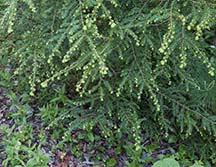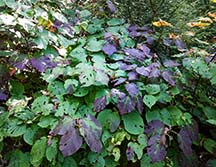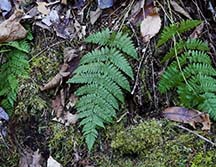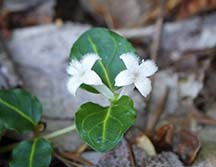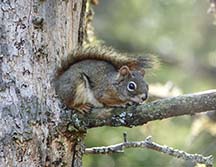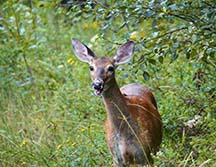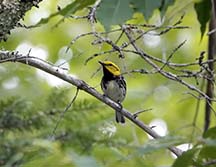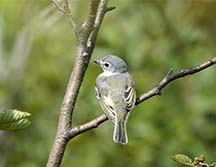Ferns of the Adirondacks:
Intermediate Wood Fern (Dryopteris intermedia)
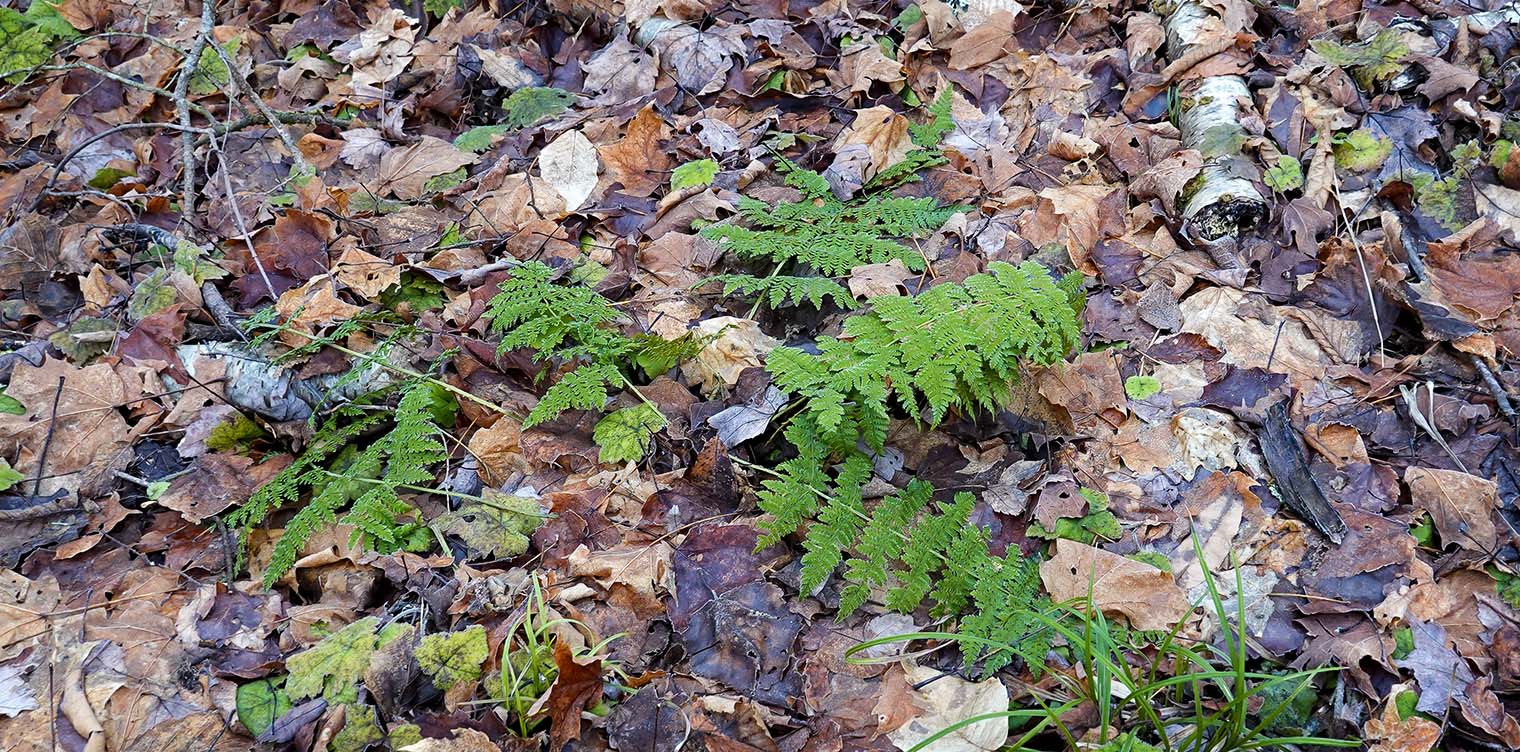
Intermediate Wood Ferns (Dryopteris intermedia), also known as Evergreen Wood Ferns or Fancy Wood Ferns, are evergreen ferns native to the Adirondack Mountains of upstate New York.
The Intermediate Wood Fern is a member of the genus Dryopteris (Wood Ferns). There are 14 Dryopteris species in North America, including eight in the Adirondack Park. In addition to the Intermediate Wood Fern, the other seven Dryopteris species within the Blue Line (not counting hybrids) are:
- Clinton's Wood Fern (Dryopteris clintoniana)
- Crested Wood Fern (Dryopteris cristata)
- Fragrant Wood Fern (Dryopteris fragrans)
- Goldie's Wood Fern (Dryopteris goldiana)
- Marginal Wood Fern (Dryopteris marginalis)
- Mountain Wood Fern (Dryopteris campyloptera)
- Spinulose Wood Fern (Dryopteris carthusiana)
Some older sources list Intermediate Wood Fern as a variety of Spinulose Wood Fern: Dryopteris spinulosa var. intermedia. This name is no longer accepted.
The genus name (Dryopteris) is from the Greek drys (oak) and pteris (fern). The species name is from the Latin intermedia (between or intermediate). Other nonscientific names include Intermediate Woodfern, Fancy Fern, Fancy Wood Fern, Evergreen Wood Fern, Evergreen Woodfern, and Common Wood Fern.
Identification of Intermediate Wood Ferns
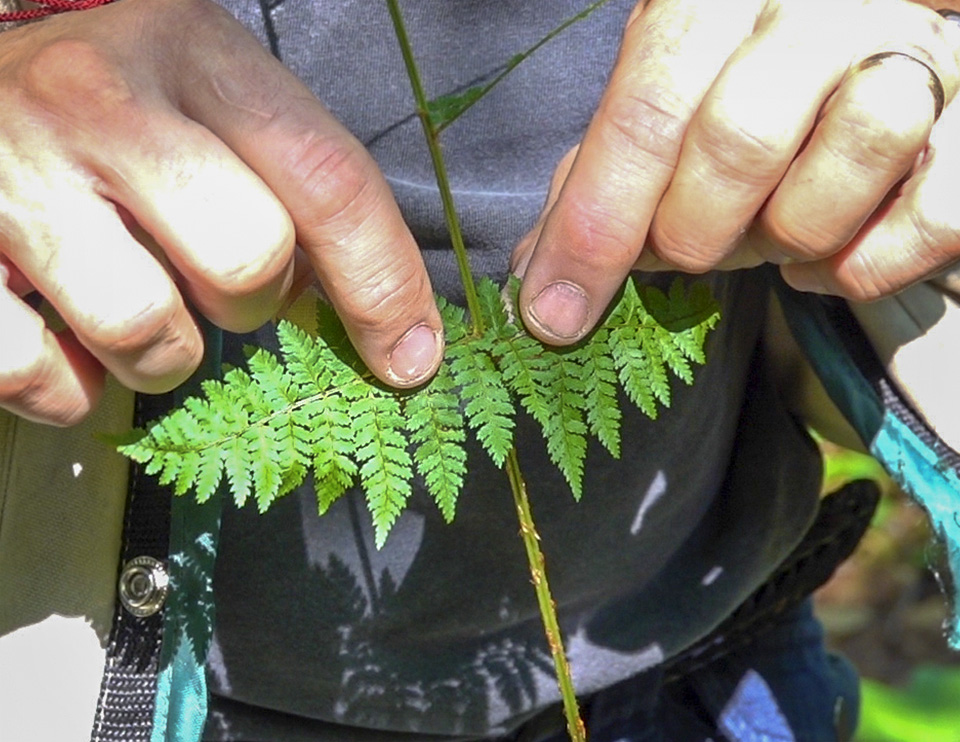
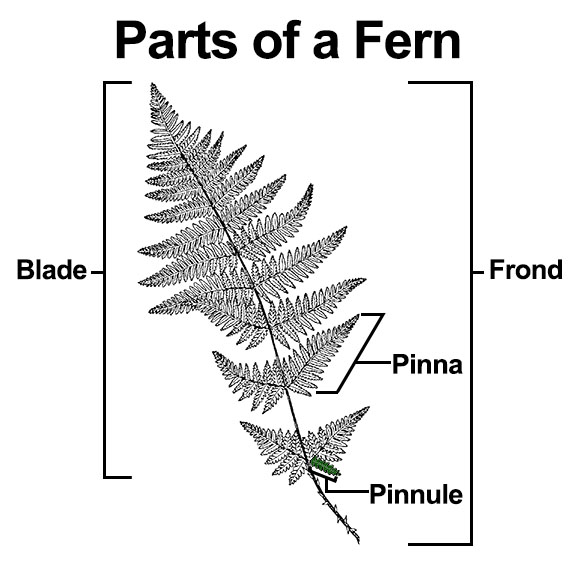 Pinnule: A division of the pinna. is shorter than the second. Intermediate Wood Fern (Dryopteris intermedia) on the Sucker Brook Trail at the Adirondack Interpretive Center (5 August 2018).
Pinnule: A division of the pinna. is shorter than the second. Intermediate Wood Fern (Dryopteris intermedia) on the Sucker Brook Trail at the Adirondack Interpretive Center (5 August 2018).Intermediate Wood Ferns are medium-sized ferns with lacy green fronds that rise in circular clusters from a central rhizome Rhizome: The modified subterranean stem of a plant that sends out roots and shoots from its nodes. Rhizomes are also called creeping rootstalks and rootstocks. (root). The rhizome is thick and densely scaled. It is erect or nearly erect.
Rhizome: The modified subterranean stem of a plant that sends out roots and shoots from its nodes. Rhizomes are also called creeping rootstalks and rootstocks. (root). The rhizome is thick and densely scaled. It is erect or nearly erect.
The fronds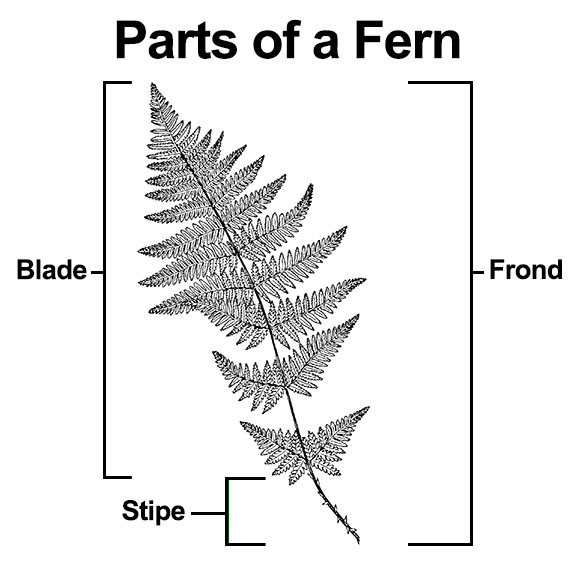 Frond: The whole leaf of a fern. It includes the blade (the expanded leafy part of the frond) and the stipe (the stalk below the blade). of the Intermediate Wood Fern are up to about three feet in length.
Frond: The whole leaf of a fern. It includes the blade (the expanded leafy part of the frond) and the stipe (the stalk below the blade). of the Intermediate Wood Fern are up to about three feet in length.
- The fertile (spore-bearing) frondsFertile frond: A frond with sporangia (spore cases). and sterile frondsSterile frond: A frond without sporangia (spore cases). are essentially the same.
- The fronds are thrice-divided, meaning that each leaflet (pinnae
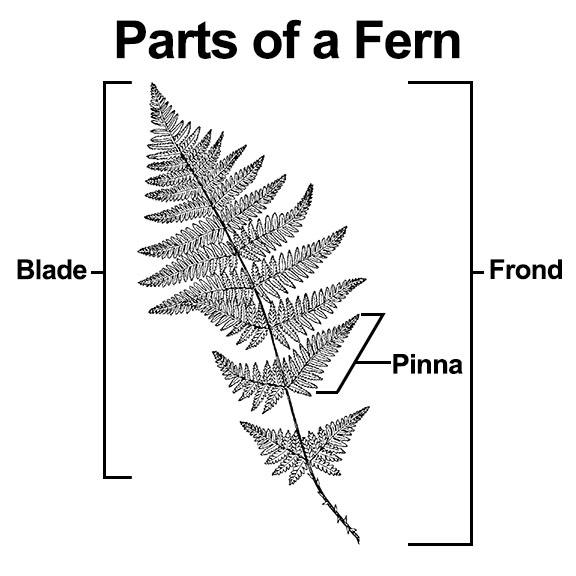 Pinna: A primary division of the blade (plural: pinnae).) is divided into subleaflets (pinnules
Pinna: A primary division of the blade (plural: pinnae).) is divided into subleaflets (pinnules Pinnule: A division of the pinna.), and each subleaflet is further divided sub-subleaflets. This gives the Intermediate Wood Fern its lacy appearance, contrasting with ferns (such as the Christmas Fern) which are once divided and ferns (such as the Cinnamon Fern, Long Beech Fern, Royal Fern, and Marginal Wood Fern ) which are twice divided.
Pinnule: A division of the pinna.), and each subleaflet is further divided sub-subleaflets. This gives the Intermediate Wood Fern its lacy appearance, contrasting with ferns (such as the Christmas Fern) which are once divided and ferns (such as the Cinnamon Fern, Long Beech Fern, Royal Fern, and Marginal Wood Fern ) which are twice divided. - The edges (marginsThe structure of the leaf's edge.) on the Intermediate Wood Fern are toothed and bristle-tipped, which also contributes to the lacy appearance of this fern.
- Unlike the fronds of deciduous ferns (such as Maidenhair Ferns, Long Beech Ferns, Royal Ferns, Hay-scented Ferns, Cinnamon Ferns, and New York Ferns) which turn color and die back with the onset of cold weather in the fall, the fronds of Intermediate Wood Fern remain green through the winter, but they change from an upright to a prostrate position.
The stipe Stipe: The stalk below the blade (the expanded, leafy part of the frond). is about ¼ to ⅓ the length of the frond. It is green to straw colored with light brown scales near the base. The stalk (rachis
Stipe: The stalk below the blade (the expanded, leafy part of the frond). is about ¼ to ⅓ the length of the frond. It is green to straw colored with light brown scales near the base. The stalk (rachis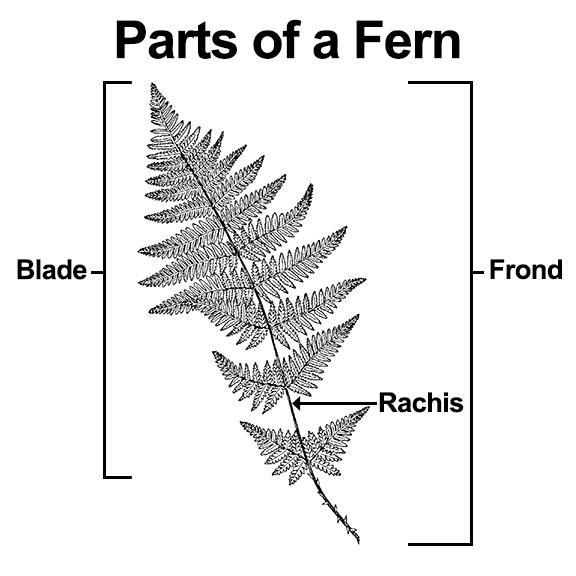 Rachis: The stalk within the blade (the expanded, leafy part of the frond).) is slightly scaled with whitish glandular hairs.
Rachis: The stalk within the blade (the expanded, leafy part of the frond).) is slightly scaled with whitish glandular hairs.
The spores of Intermediate Wood Ferns are found on the undersides of the fronds. The spores are produced in early to mid-summer. They are grouped into circular soriSorus: A cluster of spore-producing receptacles (sporangia), usually borne on the underside or margins of the pinnae or pinnules. (plural = sori) (groups of spores) which are arranged in parallel rows between the midvein and margin.
Other ferns found in the Adirondacks that might be confused with the Intermediate Wood Fern include the Spinulose Wood Fern (Dryopteris carthusiana) and Marginal Wood Fern (Dryopteris marginalis).
- To complicate matters, both the Marginal Wood Fern and the Spinulose Wood Fern are evergreen or semi-evergreen. (For the Spinulose Wood Fern, the fertile fronds are deciduous, while the sterile fronds may stay green in winter.)
- However, for both of these ferns, the first lower sub-leaflet is as long or longer than the adjacent one, while the lower sub-leaflet on the Intermediate Wood Fern is shorter than the adjacent one.
- The placement of the soriSorus: A cluster of spore-producing receptacles (sporangia), usually borne on the underside or margins of the pinnae or pinnules. (plural = sori) for the Marginal Wood Fern provides an additional clue; its sori are located near the margins.
Uses of Intermediate Wood Ferns
No medicinal or food uses for Intermediate Wood Ferns could be found.
Wildlife Value of Intermediate Wood Ferns
Intermediate Wood Ferns are of very limited use to most wildlife. These ferns are not major wildlife food plants, although White-tailed Deer may consume the evergreen foliage in harsh winters if desperate. Because the fronds become prostrate in winter, they are buried under deep snow cover. The fronds may also provide winter food for the Spruce Grouse and the Ruffed Grouse.
Distribution of Intermediate Wood Ferns
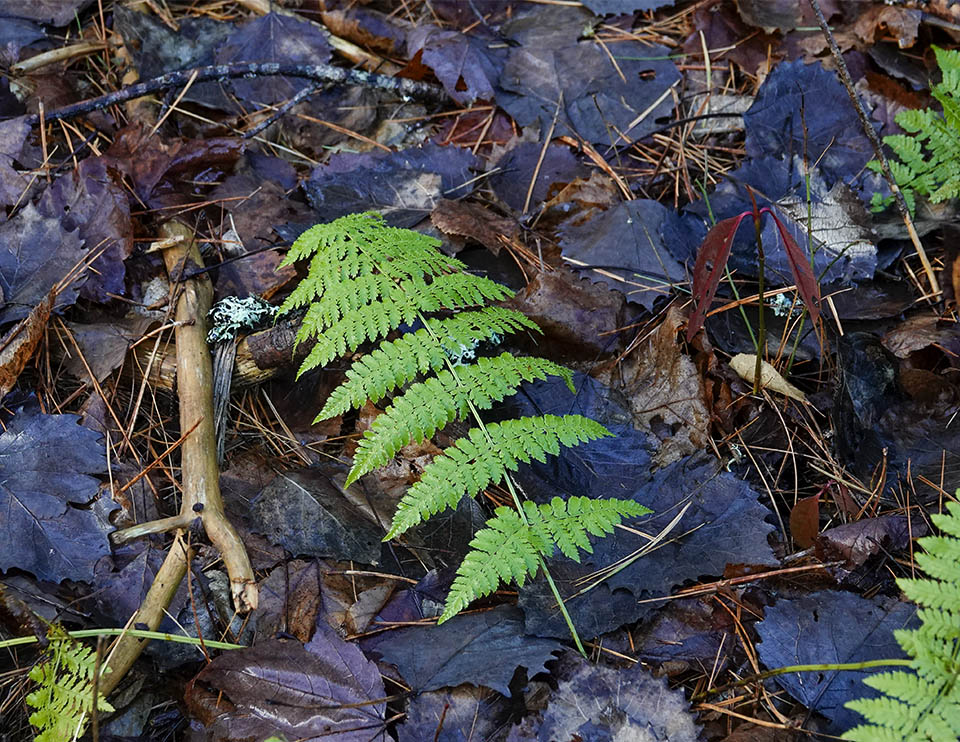
The Intermediate Wood Fern is one of the most common ferns in the eastern United States. Its range extends from Newfoundland west to Minnesota and south to Missouri, Tennessee, Alabama, Georgia, and South Carolina. This fern is listed as threatened in Iowa and exploitably vulnerable in New York State.
The Intermediate Wood Fern is found throughout New York State. Vouchered plant specimens have been registered for nearly all counties in the state, including all counties within the Adirondack Park Blue Line.
This pattern is consistent with the map of iNaturalist observations of Intermediate Wood Ferns in New York State. The insights gleaned through iNaturalist should, of course, be tempered with an awareness that the data reflect the number of observers willing to submit photos and how easily recognized a particular species is, rather than the actual abundance of the species. With this caveat in mind, it appears that Intermediate Wood Ferns are fairly common throughout much of New York State. As of late-December 2020, there were 604 research-grade iNaturalist observations of Intermediate Wood Ferns in the state. This compares with nearly 15,000 observations of all species of ferns, suggesting that this species is one of the more common ferns, although it has fewer observations than more easily recognized ferns such as Sensitive Fern, Christmas Fern, and Cinnamon Fern.
Within the Adirondack Park Blue Line, as of late-December 2020, there were 145 research-grade iNaturalist observations of Intermediate Wood Ferns. This compares with other common ferns in our region, including Sensitive Fern (124 observations), Eastern Bracken Fern (117 observations), and Christmas Fern (73 observations).
Habitat of Intermediate Wood Ferns
Plants & Wildlife of the Hemlock-Northern Hardwood Forest Ecological Community
The Intermediate Wood Fern is classified as a Facultative Upland plant (FAC), meaning that it usually occur in non-wetlands, but may occur in wetlands. In terms of site requirements, this fern can grow in well-drained to imperfectly drained sites. It occurs in acid to neutral soils. Intermediate Wood Ferns are found in a wide variety of mesic forests, including moist rocky woods, ravines, and the edges of swamps. In our region, these ferns are often found growing on decaying logs.
In the Adirondack Mountains, Intermediate Wood Ferns are found in a variety of ecological communities, including:
One of the likeliest places to find Intermediate Wood Ferns is the hemlock-northern hardwood forest – a mixed forest that typically occurs on cool, mid-elevation slopes and on moist sites at the margins of swamps.
- The canopy is dominated by Eastern Hemlock. Hemlock may be codominant with Yellow Birch, Sugar Maple, Red Maple, Eastern White Pine, Black Cherry, or American Beech.
- The shrub layer includes Hobblebush, as well as saplings of canopy trees.
- The forest floor is often densely shaded, so the ground layer may be relatively sparse. Characteristic wildflowers include Canada Mayflower, Indian Cucumber-root, Wild Sarsaparilla, Partridgeberry, Common Wood Sorrel, Jack-in-the-Pulpit, and Starflower. Other wildflowers found growing in this ecological community include Foamflower, Purple Trillium, and Sessile-leaved Bellwort.
- In addition to Intermediate Wood Ferns, characteristic ferns include Christmas Fern, other wood ferns, and Northern Lady Fern, with New York Ferns and Hay-scented Ferns appearing in canopy gaps.
- Birds frequently found in this ecological community include the Blue-headed Vireo, Black-throated Green Warbler, and Blackburnian Warbler.
Intermediate Wood Ferns can be found in some portions of virtually all of the trails covered here, since most trails traverse at least one of the ecological communities which commonly host this species. Convenient times to be on the lookout for Intermediate Wood Ferns include late fall and early winter (after the deciduous ferns have browned or died back, but before deep snow cover) and early spring (when much of the snow has disappeared, but the fiddleheads of deciduous ferns have not yet appeared).
List of Adirondack Ferns
References
Michael Kudish. Adirondack Upland Flora: An Ecological Perspective (The Chauncy Press, 1992), p. 85.
Boughton Cobb. A Field Guide to Ferns and their Related Families. Northeastern and Central North America. Second Edition (Houghton Mifflin Company, 2005), pp. 126-129, 144-145.
Michael Burgess. A Field Guide to the Ferns of New England and Adjacent New York (Undated), pp. 84-85. Retrieved 16 February 2017.
Richard Mitchell. Atlas of New York State Ferns (New York State Museum, 1984), p. 19. Retrieved 15 February 2017.
Eugene C. Ogden. Field Guide to Northeastern Ferns (New York State Museum, 1981), pp. 72-76. Retrieved 15 February 2017.
William J. Cody and Donald M. Britton. Ferns and Fern Allies of Canada (Research Branch. Agriculture Canada, 1989). Retrieved 19 February 2017.
William J. Cody. Ferns of the Ottawa District (Research Branch. Agriculture Canada, 1978), pp. 66-70. Retrieved 10 January 2018.
Cecil Billington. Ferns of Michigan (Cranbrook Institute of Science, Bulletin 32, 1952). pp. 48, 67, 167-170. Retrieved 13 December 2020.
David B. Lellinger. A Field Manual of the Ferns & Fern Allies of the United States and Canada (Smithsonian Institution Press, 1985), pp. 288-289. Retrieved 29 November 2020.
Steve W. Chadde. Northeast Ferns: A Field Guide to the Ferns and Fern Relatives of the Northeastern United States (CreateSpace Independent Publishing Platform, 2013), pp. 124-125, 144-145.
Edgar T. Wherry. The Fern Guide. Northeastern and Midland United States and Adjacent Canada (Doubleday & Company, Inc., 1961), pp. 122-123. Retrieved 13 December 2020.
William Cullina. Native Ferns, Moss & Grasses (Houghton Mifflin Company, 2008), pp. 51, 55.
R.C. Benedict, "An Adirondack Fern List," American Fern Journal, Volume 6, Number 3, July-September 1916, pp. 81-85. Retrieved 10 January 2018.
New York Flora Association. New York Flora Atlas. Evergreen Wood Fern. Dryopteris intermedia. Retrieved 14 December 2020.
Integrated Taxonomic Information System. Dryopteris intermedia. Retrieved 14 December 2020.
Integrated Taxonomic Information System. Dryopteris spinulosa var. intermedia. Retrieved 14 December 2020.
United States Department of Agriculture. The Plants Database. Intermediate Woodfern. Dryopteris intermedia. Retrieved 14 December 2020.
Gregory T. Munger, “Dryopteris spp.,” Fire Effects Information System (FEIS). Species Reviews. Forest Service, Rocky Mountain Research Station, Fire Sciences Laboratory (United States Department of Agriculture, 2007). Retrieved 14 December 2020.
Flora of North America. Dryopteris intermedia. Retrieved 15 December 2020.
NatureServe Explorer. NatureServe, Arlington, Virginia. Tsuga canadensis - Acer saccharum - Fagus grandifolia / Dryopteris intermedia Forest. Retrieved 15 December 2020.
NatureServe Explorer. NatureServe, Arlington, Virginia. Tsuga canadensis - Betula alleghaniensis - Acer saccharum / Dryopteris intermedia Forest. Retrieved 15 December 2020.
iNaturalist. Intermediate Wood Fern. Dryopteris intermedia. Retrieved 21 December 2020.
iNaturalist. Adirondack Park Observations. Intermediate Wood Fern. Dryopteris intermedia. Retrieved 21 December 2020.
Native Plant Trust. Go Botany. Dryopteris intermedia. Evergreen Wood Fern. Retrieved 18 December 2020.
New York State. Department of Environmental Conservation. New York Natural Heritage Program. Ecological Communities of New York State. Second Edition (March 2014), pp. 118-123. Retrieved 17 October 2015.
New York Natural Heritage Program. 2020. Online Conservation Guide for Appalachian Oak-Pine Forest. Retrieved 12 December 2020.
New York Natural Heritage Program. 2020. Online Conservation Guide for Balsam Flats. Retrieved 12 December 2020.
New York Natural Heritage Program. 2020. Online Conservation Guide for Beech-Maple Mesic Forest. Retrieved 12 December 2020.
New York Natural Heritage Program. 2020. Online Conservation Guide for Hemlock-Northern Hardwood Forest. Retrieved 12 December 2020.
New York Natural Heritage Program. 2020. Online Conservation Guide for Mountain Fir Forest. Retrieved 14 December 2020.
New York Natural Heritage Program. 2020. Online Conservation Guide for Spruce-Northern Hardwood Forest. Retrieved 12 December 2020.
New York State. Adirondack Park Agency. Preliminary List of Species Native Within the Adirondack Park Listed Alphabetically by Scientific Name and Sorted by Habit. Volume 1. Updated 10.23.2006, p. 58. Retrieved 26 January 2017.
Connecticut Botanical Society. Intermediate Woodfern. Dryopteris intermedia. Retrieved 18 December 2020.
University of Wisconsin. Flora of Wisconsin. Fancy Wood Fern. Dryopteris intermedia. Retrieved 18 December 2020.
Minnesota Wildflowers. A Field Guide to the Flora of Minnesota. Glandular Wood Fern. Dryopteris intermedia. Retrieved 18 December 2020.
Lady Bird Johnson Wildflower Center. Dryopteris intermedia. Retrieved 18 December 2020.
New York State Department of Environmental Conservation. Winter Deer Foods. Retrieved 18 December 2020.
Gary Wade et al. Vascular Plant Species of the Forest Ecology Research and Demonstration Area, Paul Smiths, New York. USDA Forest Service. Research Note NE-380, p. 4-5. Retrieved 22 January 2017.
Mark J. Twery, et al. Changes in Abundance of Vascular Plants under Varying Silvicultural Systems at the Forest Ecosystem Research and Demonstration Area, Paul Smiths, New York. USDA Forest Service. Research Note NRS-169, p. 8. Retrieved 22 January 2017.
Alexander C. Martin, Herbert S. Zim, and Arnold L. Nelson. American Wildlife & Plants. A Guide to Wildlife Food Habits (Dover Publications, 1951), pp. 93-94, 268-269, 369. Retrieved 15 December 2020.
John Eastman. The Book of Forest and Thicket: Trees, Shrubs, and Wildflowers of Eastern North America (Stackpole Books, 1992), pp. 83-85.
Allen J. Coombes. Dictionary of Plant Names (Timber Press, 1994), p. 63. Retrieved 18 December 2020.
Charles H. Peck. Plants of North Elba. (Bulletin of the New York State Museum, Volume 6, Number 28, June 1899), p. 154. Retrieved 22 February 2017.
"What the Latin Name Means I," American Fern Journal, Volume 10, Number 4 (October-December 1920), pp. 113-115. Retrieved 10 January 2018.
Gregory G. McGee, “Stand-Level Effects on the Role of Decaying Logs as Vascular Plant Habitat in Adirondack Northern Hardwood Forests,” The Journal of the Torrey Botanical Society, Volume 128, Number. 4 (October - December 2001), pp. 370-380. Retrieved 15 December 2020.

